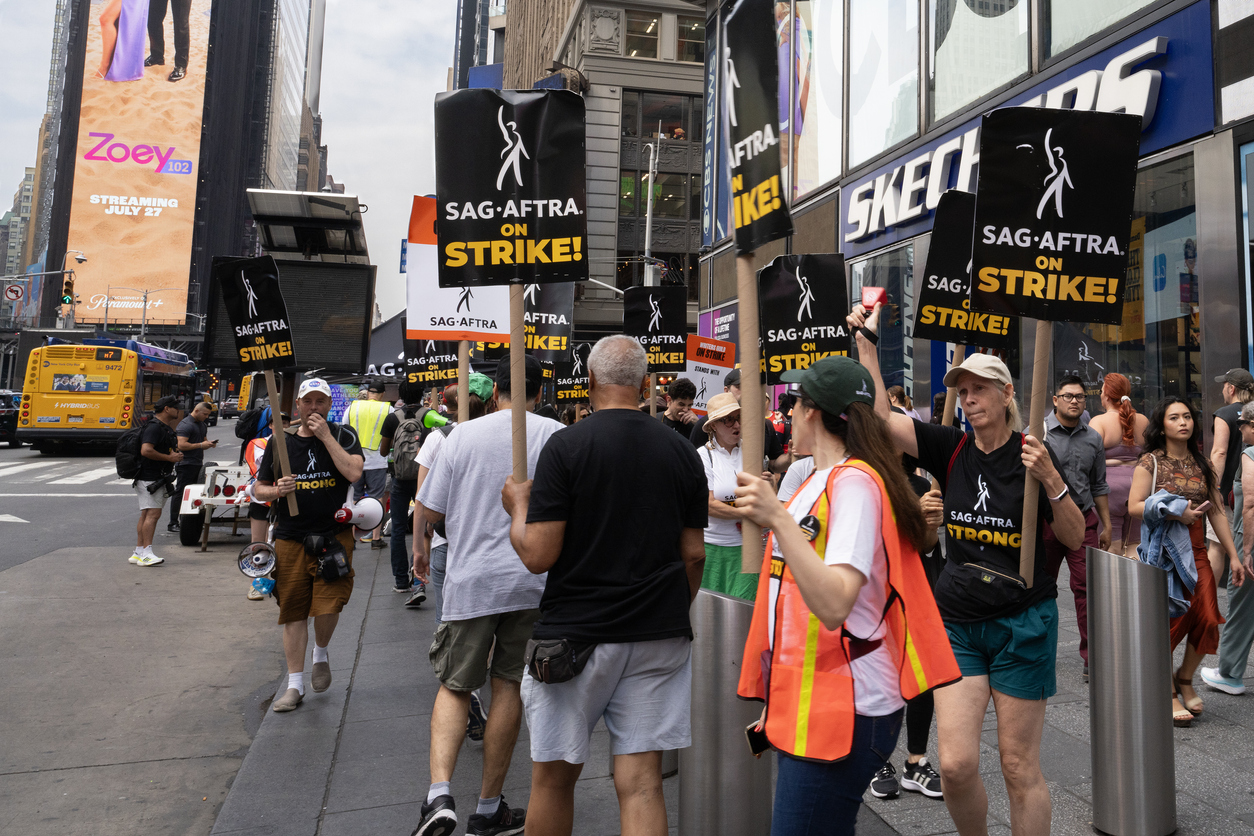Art is work: Creative labor at a crossroads
Why this Labor Day is different from all others — and what it means for communicators.

Driving down the Palisades Parkway a few weeks back, my car stopped in traffic behind a bumper sticker with a simple but profound message: “Art is work.”
This sentiment reverberates loudly at home these days — my partner, a scenic artist for film and television and member of the International Alliance of Theatrical Stage Employees (IATSE) union — has been out of work since late April due to the ongoing writers’ and actors’ strikes that have shut down most productions.
That bumper sticker captured, in three words, the feeling among many writers, actors and artists that their creative skills are consistently undervalued in the interest of bottom lines, streamlined productivity and lower operating costs. The industry’s powers-that-be, the affected creatives believe, don’t understand that quality creative work requires the human synthesis and translation of lived experience, judgement and discretion.
The writers say they’re striking for, among other things, job protection amid the growing influence of generative artificial intelligence (AI) on the writing process. The actors also strike for protections against AI, specifically its ability to capture and reuse their likeness in perpetuity, its ability to replicate extras in the background of shots and more. In the quality versus quantity debate, both parties want to ensure that any applications of AI in their respective creative fields are not undertaken at the expense of the expertise they’ve been trained and hired to provide.
While Ragan regularly covers and encourages responsible, effective use cases for AI in communications, there’s no question that this Labor Day arrives at an inflection point for creatives. The Hollywood writers’ and actors’ strikes continue after months of stalled negotiations and demoralizing messages from Hollywood executives.
Zooming out, segmented labor relations across industries are so tenuous that the U.S. Treasury Department released a first-of-its-kind report earlier this week, written by the Department’s Office of Economic Policy, that explains how unions play an important role in addressing the myriad of challenges facing the American middle class. This fact sheet goes deeper into the findings, including how the benefits of unionization will spill over to non-union workers, too, contributing to overall economic growth and resilience.
“Income inequality often feeds back into inequality of opportunity” the fact sheet reads, “which impedes growth if disadvantaged people cannot access the resources necessary to acquire job skills or start businesses.”
Last month, Ragan Content Director Jess Zafarris wrote a thoughtful piece on how communicators should respond to, and prepare for, employee unionization efforts. But Communicators would also do well to consider the concerns being raised by the actors and writers striking, concerns that, if unaddressed, can alter the future of the communications function, too.
How communicators can help
Last week, Tony Gilroy, filmmaker and creator of the beloved Star Wars Disney+ show “Andor,” gave an impassioned speech from the WGA picket line. “We ARE the content,” he said. “It is OUR ideas that fill the theme parks and the toy stores, our characters on the lunchboxes and the Halloween costumes. We are the national resource from which the product is made, and we are tired of being strip-mined.”
(WATCH) Tony Gilroy speaks to demonstrators today at the NYC screenwriters picket #WritersStrike pic.twitter.com/mvRAzoI6jA
— Deadline Hollywood (@DEADLINE) August 24, 2023
Gilroy’s words underscore a sentiment felt by content teams across industries these days, and they were spoken on behalf of writers who want assurance that automation and other emerging technologies won’t take precedence over their skills, judgement and tact. “Content” has long been a catch-all, medium-agnostic term for creative work. It could refer to a piece of social copy written in minutes or a longform, multimedia enterprise feature that took months to report and produce. It could refer to a video posted to TikTok or a scripted series on a streaming platform.
As such, communicators should consider how often they use this word, in what contexts, and whether they ever wield it haphazardly as an anonymizing term that robs the worker of their agency. Practitioners of this function understand more than most that the words they use matter. This is an under-acknowledged, but nonetheless relevant example.
It’s also important for communicators to understand the current state of AI copyright regulations. This August, the US District Court for the District of Columbia ruled that AI-generated work can’t be copyrighted if it is “absent any guiding human hand,” emphasizing that “[h]uman authorship is a bedrock requirement of copyright.” Yesterday, the US Copyright Office opened a public comment period to hear people’s ideas and concerns about AI as it pertains to ownership. What the institution learns will inform its rules and regulations going forward.
The present moment is an opportune time to facilitate an honest dialogue with employees about creative output, too. Communicators can remind leaders looking to jump headfirst into automation that their ownership of AI-generated work may soon only be protected when it has human fingerprints on it. Communicators can advocate for their organizations providing employee training on writing with generative AI platforms, machine learning and other automation skills that address where the needs of the business intersect with employee career aspirations.
More broadly, communicators can also make the expectations of work for their team as detailed as possible during onboarding and the review process, with an emphasis on defining reasonable timelines and processes for the completion of creative work— including how automation will or won’t fit into new workflows. This will require working with senior leaders to learn exactly what they expect from a role, codifying it in writing and making sure those leaders maintain an accountable line of sight.
Easier said than done, sure, but communicators aren’t in this alone. They can partner HR or people teams by positioning the exercise as a compliance and productivity issue.
Another tangible way communicators can help: Training leaders on project management and workflow systems. Keeping those up-to-date and holding them up as a single source of truth, then educating leaders on how communicators assess the ability to satisfy ad-hoc requests, will illuminate the communications logic and strategy while ensuring enough space exists for creative employees to execute their work at the highest level of quality possible.
Of course, this all depends on the buy-in and willingness of leaders to recognize that art is work.
It’s crucial to remember that creativity takes time and human agency, but that time is well-spent when the quality of the work is high. Validating that work on our teams by quantifying it, defining it and communicating what’s expected of your creative employees will foster a sense of solidarity that only makes the work — and the business — stronger.
Justin Joffe is the editor-in-chief at Ragan Communications. Before joining Ragan, Joffe worked as a journalist and communications writer specializing in the arts and culture, media and technology, PR and ad tech beats. His writing has appeared in several publications including Vulture, Newsweek, Vice, Relix, Flaunt, and many more.







